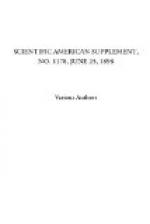the average load for the whole year is 3.7 per cent.
of the maximum demand on you for current at any one
time during that period; or, to put it in another
way, this load factor of 3.7 per cent. would show that
your investment is in use the equivalent of a little
over 323 hours a year on this class of business.
This is by no means an extreme case. You can
find in almost every large city customers whose load
factors are not nearly as favorable to the operating
company, their use of your investment being as low
as the equivalent of 75 or 100 hours a year.
Take another class of business, that of the haberdasher,
or small fancy goods store. As a rule these stores
are comparatively small, with facilities for getting
a large amount of natural light and little use for
artificial light. The load factor as shown by
the chart is about 7 per cent., the use of your investment
being not quite twice as long as that of the office
building. Day saloons show an average of 16 per
cent. load factor; cafetiers and small lunch counters
about 20 per cent., while the large dry goods stores,
in which there is comparatively little light, have
a load factor of 25 per cent. and use your investment
seven times as long per year as the office building.
Power business naturally shows a still better load
factor, say 35 per cent., and the all-night restaurant
has a load factor of 48 per cent.
You will see from this that the great desideratum
of the central station system is, from the investors’
point of view, the necessity of getting customers
for your product whose business is of such a character
as to call for a low maximum and long average use.
This question of load factor is by all means the most
important one in central station economy. If
your maximum is very high and your average consumption
very low, heavy interest charges will necessarily follow.
The nearer you can bring your average to your maximum
load, the closer you approximate to the most economical
conditions of production, and the lower you can afford
to sell your current. Take, for instance, the
summer and winter curves of the Chicago Edison company.
The curve of December 20, 1897, shows a load factor
of about 48 per cent.; the curve of May 2, 1898, shows
a load factor of nearly 60 per cent. Now, if
we were able in Chicago to get business of such a character
as would give us a curve of the same characteristics
in December as the curve we get in May; or, in other
words, if we could improve our load factor, our interest
cost would be reduced, an effect would be produced
upon the other items going to make up the cost of current,
and we probably could make more money out of our customers
at a lower price per unit than we get from them now.




